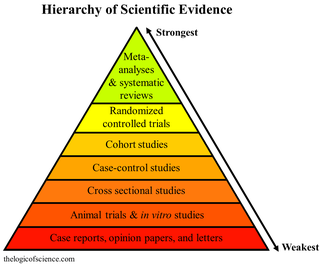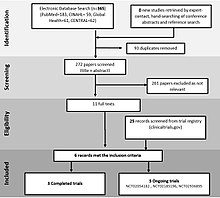
A meta-analysis is a statistical analysis that combines the results of multiple scientific studies. Meta-analyses can be performed when there are multiple scientific studies addressing the same question, with each individual study reporting measurements that are expected to have some degree of error. The aim then is to use approaches from statistics to derive a pooled estimate closest to the unknown common truth based on how this error is perceived. It is thus a basic methodology of Metascience. Meta-analytic results are considered the most trustworthy source of evidence by the evidence-based medicine literature.

A randomized controlled trial is a form of scientific experiment used to control factors not under direct experimental control. Examples of RCTs are clinical trials that compare the effects of drugs, surgical techniques, medical devices, diagnostic procedures or other medical treatments.

The Cochrane Collaboration is a British international charitable organisation formed to synthesise medical research findings to facilitate evidence-based choices about health interventions involving health professionals, patients and policy makers. It includes 53 review groups that are based at research institutions worldwide. Cochrane has approximately 30,000 volunteer experts from around the world.
In published academic research, publication bias occurs when the outcome of an experiment or research study biases the decision to publish or otherwise distribute it. Publishing only results that show a significant finding disturbs the balance of findings in favor of positive results. The study of publication bias is an important topic in metascience.

A systematic review is a scholarly synthesis of the evidence on a clearly presented topic using critical methods to identify, define and assess research on the topic. A systematic review extracts and interprets data from published studies on the topic, then analyzes, describes, critically appraises and summarizes interpretations into a refined evidence-based conclusion. For example, a systematic review of randomized controlled trials is a way of summarizing and implementing evidence-based medicine.
In statistics, (between-) study heterogeneity is a phenomenon that commonly occurs when attempting to undertake a meta-analysis. In a simplistic scenario, studies whose results are to be combined in the meta-analysis would all be undertaken in the same way and to the same experimental protocols. Differences between outcomes would only be due to measurement error. Study heterogeneity denotes the variability in outcomes that goes beyond what would be expected due to measurement error alone.
In medicine, a case report is a detailed report of the symptoms, signs, diagnosis, treatment, and follow-up of an individual patient. Case reports may contain a demographic profile of the patient, but usually describe an unusual or novel occurrence. Some case reports also contain a literature review of other reported cases. Case reports are professional narratives that provide feedback on clinical practice guidelines and offer a framework for early signals of effectiveness, adverse events, and cost. They can be shared for medical, scientific, or educational purposes.
Consolidated Standards of Reporting Trials (CONSORT) encompasses various initiatives developed by the CONSORT Group to alleviate the problems arising from inadequate reporting of randomized controlled trials. It is part of the larger EQUATOR Network initiative to enhance the transparency and accuracy of reporting in research.
The STROBE(STrengthening the Reporting of OBservational studies in Epidemiology) Statement is a reporting guideline including a checklist of 22 items that are considered essential for good reporting of observational studies. It was published simultaneously in several leading biomedical journals in October and November 2007 and comprises both the checklist and an explanation and elaboration article which gives examples of good reporting and provides authors with more guidance on good reporting. It is also referred to in the Uniform Requirements for Manuscripts Submitted to Biomedical Journals established by the International Committee of Medical Journal Editors and is endorsed by hundreds of biomedical journals.
The Jadad scale, sometimes known as Jadad scoring or the Oxford quality scoring system, is a procedure to assess the methodological quality of a clinical trial by objective criteria. It is named after Canadian-Colombian physician Alex Jadad who in 1996 described a system for allocating such trials a score of between zero and five (rigorous). It is the most widely used such assessment in the world, and as of 2022, its seminal paper has been cited in over 23,000 scientific works.

John P. A. Ioannidis is a Greek-American physician-scientist, writer and Stanford University professor who has made contributions to evidence-based medicine, epidemiology, and clinical research. Ioannidis studies scientific research itself, meta-research primarily in clinical medicine and the social sciences.
Critical appraisal in evidence based medicine, is the use of explicit, transparent methods to assess the data in published research, applying the rules of evidence to factors such as internal validity, adherence to reporting standards, conclusions, generalizability and risk-of-bias. Critical appraisal methods form a central part of the systematic review process. They are used in evidence synthesis to assist clinical decision-making, and are increasingly used in evidence-based social care and education provision.
The Enhancing the Quality and Transparency of health research Network is an international initiative aimed at promoting transparent and accurate reporting of health research studies to enhance the value and reliability of medical research literature. The EQUATOR Network was established with the goals of raising awareness of the importance of good reporting of research, assisting in the development, dissemination and implementation of reporting guidelines for different types of study designs, monitoring the status of the quality of reporting of research studies in the health sciences literature, and conducting research relating to issues that impact the quality of reporting of health research studies. The Network acts as an "umbrella" organisation, bringing together developers of reporting guidelines, medical journal editors and peer reviewers, research funding bodies, and other key stakeholders with a mutual interest in improving the quality of research publications and research itself. The EQUATOR Network comprises four centres at the University of Oxford, Bond University, Paris Descartes University, and Ottawa Hospital Research Institute.
Alessandro Liberati was an Italian healthcare researcher and clinical epidemiologist, and founder of the Italian Cochrane Centre.
Lesley Ann Stewart is a Scottish academic whose research interests are in the development and application of evidence synthesis methods, particularly systematic reviews and individual participant data meta-analysis. She is head of department for the Centre for Reviews and Dissemination at the University of York and director for the NIHR Evidence Synthesis Programme. She was one of the founders of the Cochrane Collaboration in 1993. Stewart served as president of the Society for Research Synthesis Methodology (2013-2016) and was a founding co-editor in chief of the academic journal Systematic Reviews (2010–2021).

Cynthia Mulrow is an American physician and scholar from Edinburg, Texas. She has regularly contributed academic research on many topics to the medical community. Her academic work mainly focuses on systematic reviews and evidence reports, research methodology, and chronic medical conditions.

Allegiance bias in behavioral sciences is a bias resulted from the investigator's or researcher's allegiance to a specific school of thought. Researchers/investigators have been exposed to many types of branches of psychology or schools of thought. Naturally they adopt a school or branch that fits with their paradigm of thinking. More specifically, allegiance bias is when this leads therapists, researchers, etc. believing that their school of thought or treatment is superior to others. Their superior belief to these certain schools of thought can bias their research in effective treatments trials or investigative situations leading to allegiance bias. Reason being is that they may have devoted their thinking to certain treatments they have seen work in their past experiences. This can lead to a fundamental errors to the results of their research they are conducting. Their “pledge” to stay within their own paradigm of thinking may affect their ability to find more effective treatments to help the patient or situation they are investigating.
The International Prospective Register of Systematic Reviews, better known as PROSPERO, is an open access online database of systematic review protocols on a wide range of topics. While it was initially restricted to medicine, as of 2021, it also accepts protocols in criminology, social care, education and international development, as long as there is a health-related outcome. Researchers can choose to have their reviews prospectively registered with PROSPERO. The database is produced by the Centre for Reviews and Dissemination at the University of York in England, and it is funded by the National Institute for Health Research. Registration of systematic reviews in the database has been supported by PLoS Medicine, BioMed Central, the EQUATOR Network, and BMJ editor-in-chief Fiona Godlee, among others.
Virginia M. Barbour is a professor at Queensland University of Technology in Brisbane, Australia, and serves as the Director of the Australasian Open Access Strategy Group. She is best known for being one of the three founding editors of PLOS Medicine, and her various roles in championing the open access movement.
A non-pharmaceutical intervention or non-pharmacological intervention (NPI) is any type of health intervention which is not primarily based on medication. Some examples include exercise, sleep improvement, or dietary habits.








